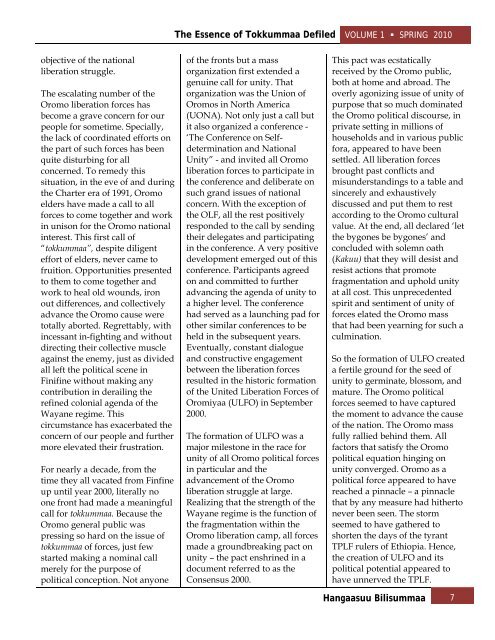Hangaasuu Bilisummaa Journal Volume 1 - ULFO
Hangaasuu Bilisummaa Journal Volume 1 - ULFO
Hangaasuu Bilisummaa Journal Volume 1 - ULFO
You also want an ePaper? Increase the reach of your titles
YUMPU automatically turns print PDFs into web optimized ePapers that Google loves.
objective of the national<br />
liberation struggle.<br />
The escalating number of the<br />
Oromo liberation forces has<br />
become a grave concern for our<br />
people for sometime. Specially,<br />
the lack of coordinated efforts on<br />
the part of such forces has been<br />
quite disturbing for all<br />
concerned. To remedy this<br />
situation, in the eve of and during<br />
the Charter era of 1991, Oromo<br />
elders have made a call to all<br />
forces to come together and work<br />
in unison for the Oromo national<br />
interest. This first call of<br />
“tokkummaa”, despite diligent<br />
effort of elders, never came to<br />
fruition. Opportunities presented<br />
to them to come together and<br />
work to heal old wounds, iron<br />
out differences, and collectively<br />
advance the Oromo cause were<br />
totally aborted. Regrettably, with<br />
incessant in-fighting and without<br />
directing their collective muscle<br />
against the enemy, just as divided<br />
all left the political scene in<br />
Finifine without making any<br />
contribution in derailing the<br />
refined colonial agenda of the<br />
Wayane regime. This<br />
circumstance has exacerbated the<br />
concern of our people and further<br />
more elevated their frustration.<br />
For nearly a decade, from the<br />
time they all vacated from Finfine<br />
up until year 2000, literally no<br />
one front had made a meaningful<br />
call for tokkummaa. Because the<br />
Oromo general public was<br />
pressing so hard on the issue of<br />
tokkummaa of forces, just few<br />
started making a nominal call<br />
merely for the purpose of<br />
political conception. Not anyone<br />
The Essence of Tokkummaa Defiled VOLUME 1 SPRING 2010<br />
of the fronts but a mass<br />
organization first extended a<br />
genuine call for unity. That<br />
organization was the Union of<br />
Oromos in North America<br />
(UONA). Not only just a call but<br />
it also organized a conference -<br />
‘The Conference on Selfdetermination<br />
and National<br />
Unity” - and invited all Oromo<br />
liberation forces to participate in<br />
the conference and deliberate on<br />
such grand issues of national<br />
concern. With the exception of<br />
the OLF, all the rest positively<br />
responded to the call by sending<br />
their delegates and participating<br />
in the conference. A very positive<br />
development emerged out of this<br />
conference. Participants agreed<br />
on and committed to further<br />
advancing the agenda of unity to<br />
a higher level. The conference<br />
had served as a launching pad for<br />
other similar conferences to be<br />
held in the subsequent years.<br />
Eventually, constant dialogue<br />
and constructive engagement<br />
between the liberation forces<br />
resulted in the historic formation<br />
of the United Liberation Forces of<br />
Oromiyaa (<strong>ULFO</strong>) in September<br />
2000.<br />
The formation of <strong>ULFO</strong> was a<br />
major milestone in the race for<br />
unity of all Oromo political forces<br />
in particular and the<br />
advancement of the Oromo<br />
liberation struggle at large.<br />
Realizing that the strength of the<br />
Wayane regime is the function of<br />
the fragmentation within the<br />
Oromo liberation camp, all forces<br />
made a groundbreaking pact on<br />
unity – the pact enshrined in a<br />
document referred to as the<br />
Consensus 2000.<br />
This pact was ecstatically<br />
received by the Oromo public,<br />
both at home and abroad. The<br />
overly agonizing issue of unity of<br />
purpose that so much dominated<br />
the Oromo political discourse, in<br />
private setting in millions of<br />
households and in various public<br />
fora, appeared to have been<br />
settled. All liberation forces<br />
brought past conflicts and<br />
misunderstandings to a table and<br />
sincerely and exhaustively<br />
discussed and put them to rest<br />
according to the Oromo cultural<br />
value. At the end, all declared ‘let<br />
the bygones be bygones’ and<br />
concluded with solemn oath<br />
(Kakuu) that they will desist and<br />
resist actions that promote<br />
fragmentation and uphold unity<br />
at all cost. This unprecedented<br />
spirit and sentiment of unity of<br />
forces elated the Oromo mass<br />
that had been yearning for such a<br />
culmination.<br />
So the formation of <strong>ULFO</strong> created<br />
a fertile ground for the seed of<br />
unity to germinate, blossom, and<br />
mature. The Oromo political<br />
forces seemed to have captured<br />
the moment to advance the cause<br />
of the nation. The Oromo mass<br />
fully rallied behind them. All<br />
factors that satisfy the Oromo<br />
political equation hinging on<br />
unity converged. Oromo as a<br />
political force appeared to have<br />
reached a pinnacle – a pinnacle<br />
that by any measure had hitherto<br />
never been seen. The storm<br />
seemed to have gathered to<br />
shorten the days of the tyrant<br />
TPLF rulers of Ethiopia. Hence,<br />
the creation of <strong>ULFO</strong> and its<br />
political potential appeared to<br />
have unnerved the TPLF.<br />
<strong>Hangaasuu</strong> <strong>Bilisummaa</strong> 7


